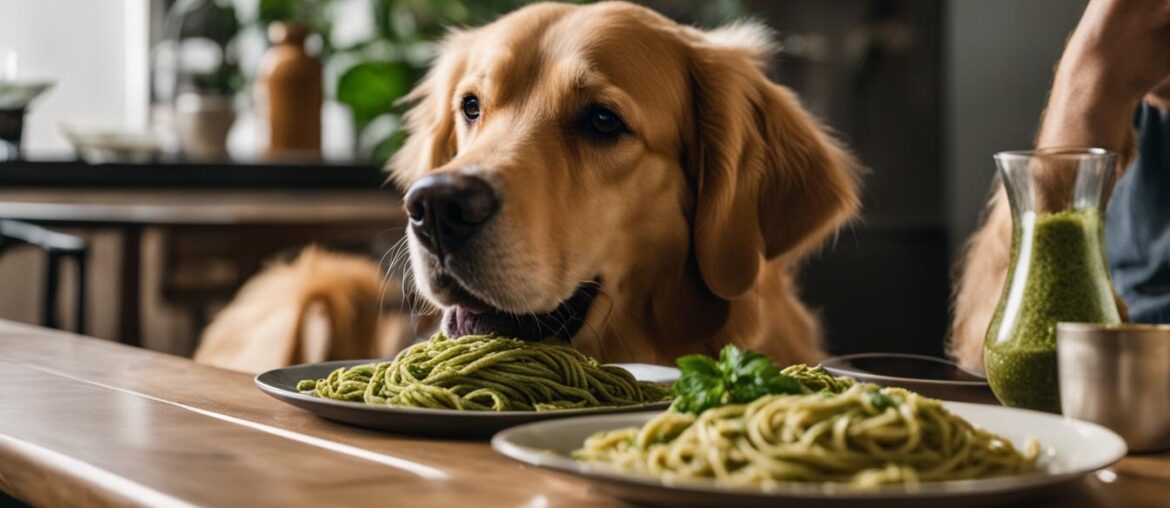As a professional copywriting journalist, I am here to provide you with essential information on whether dogs can safely consume pesto.
Pesto may be a beloved condiment for humans, but it is important to understand that dogs should not eat pesto. Pesto contains ingredients that can be toxic and harmful to dogs.
One of the main ingredients in pesto is garlic, which can lead to severe symptoms in dogs, including increased heart rate, pale gums, rapid breathing, and even collapse. Garlic and onion can break down a dog’s red blood cells, causing anemia. Additionally, pesto is high in salt and fat, which can be dangerous to dogs in excess. Foods high in fat can cause pancreatitis, while large amounts of salt can lead to salt poisoning.
Even if you are considering homemade pesto, it is best to avoid feeding dogs any form of pesto. Homemade pesto may not contain garlic and onion, but it still poses risks due to its high salt and fat content. Vegan pesto, which contains soy, can also be problematic for dogs who are allergic to soy.
If your dog accidentally ingests pesto, it is crucial to take immediate action. Contact your veterinarian or a pet poison hotline for guidance based on your dog’s size, the amount ingested, and the specific ingredients in the pesto. Inducing vomiting at home should only be done under professional guidance.
Key Takeaways:
- Pesto is toxic to dogs and should not be fed to them due to its ingredients.
- Garlic and onion in pesto can cause anemia and severe symptoms in dogs.
- Pesto is high in salt and fat, which can be dangerous to dogs in excess.
- Homemade pesto is not a safe alternative for dogs due to its high salt and fat content.
- If your dog ingests pesto, contact your veterinarian or a pet poison hotline for guidance.
Why is Pesto Toxic to Dogs?

Pesto is a delicious sauce that many humans enjoy, but it can be extremely toxic to dogs. The main reason for this toxicity is the presence of garlic and onion in pesto. Both garlic and onion contain compounds that are harmful to dogs and can cause serious health issues when ingested.
Garlic and onion contain organosulfur compounds that can damage a dog’s red blood cells. This leads to a condition called hemolytic anemia, where the dog’s body destroys its own red blood cells at a faster rate than it can produce new ones. The destruction of red blood cells can result in symptoms such as increased heart rate, pale gums, rapid breathing, weakness, and even collapse.
The toxic effects of garlic and onion can build up in a dog’s system over time, especially if they consume pesto repeatedly or in large amounts. Even a small amount of pesto containing garlic and onion can pose a significant risk to a dog’s health.
In addition to the dangers posed by garlic and onion, pesto is also high in salt and fat, which can be problematic for dogs. Excessive salt intake can lead to salt poisoning in dogs, causing symptoms such as dehydration, decreased appetite, lack of coordination, and stomach upset. High-fat foods, on the other hand, can increase the risk of pancreatitis, which is the inflammation of the pancreas. Pancreatitis can result in symptoms such as vomiting, diarrhea, abdominal pain, and in severe cases, even death.
Therefore, it is crucial to keep dogs away from pesto and ensure they do not consume any foods containing garlic, onion, excessive salt, or high levels of fat. Feeding dogs a balanced and appropriate diet that meets their nutritional needs, without the inclusion of harmful ingredients, is the best way to protect their health and well-being.
| Toxicity Factors in Pesto | Health Risks |
|---|---|
| Garlic and Onion | – Hemolytic anemia – Increased heart rate – Pale gums – Rapid breathing – Weakness – Collapse |
| Salt | – Salt poisoning – Dehydration – Decreased appetite – Lack of coordination – Stomach upset |
| Fat | – Pancreatitis – Vomiting – Diarrhea – Abdominal pain |
Can Dogs Eat Homemade Pesto?
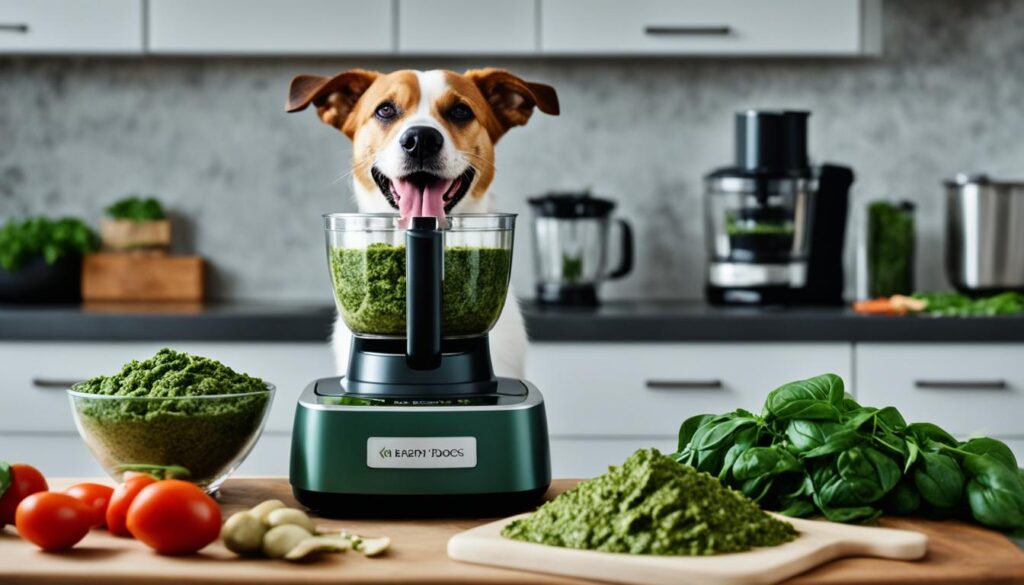
When it comes to homemade pesto, dogs should not be given any, as it can still contain ingredients that are toxic to them, such as garlic and onion. Although some dog-friendly pesto recipes can be made without garlic and onion, it is best to avoid feeding dogs any form of pesto. Instead, there are safer alternatives that you can consider.
Instead of homemade pesto, you can create homemade sauces using dog-safe ingredients like basil, parsley, and other herbs and spices that are safe for dogs to consume. These ingredients can add flavor to your dog’s meals without posing any harm to their health. Here are some dog-friendly herbs and spices that you can use:
Dog-Friendly Herbs and Spices for Pesto:
- Basil
- Parsley
- Oregano
- Thyme
By incorporating these dog-safe herbs and spices into your homemade sauces, you can create a flavorful and healthy alternative to pesto for your canine companion. Remember to use them in moderation and consult with a veterinarian if you have any concerns or questions about your dog’s diet.
| Ingredients | Instructions |
|---|---|
| 1 cup fresh basil leaves | 1. Wash the basil leaves thoroughly. |
| 1/4 cup parsley | 2. Chop the parsley finely. |
| 1/4 cup unsalted chicken or vegetable broth | 3. Combine the basil leaves, parsley, and broth in a blender or food processor. |
| 1 tablespoon olive oil | 4. Blend the ingredients until smooth. |
| Optional: Add more broth for desired consistency | 5. Adjust the consistency by adding more broth if necessary. |
| 6. Serve the homemade sauce as a flavor enhancer for your dog’s meals. |
What to Do If Your Dog Eats Pesto
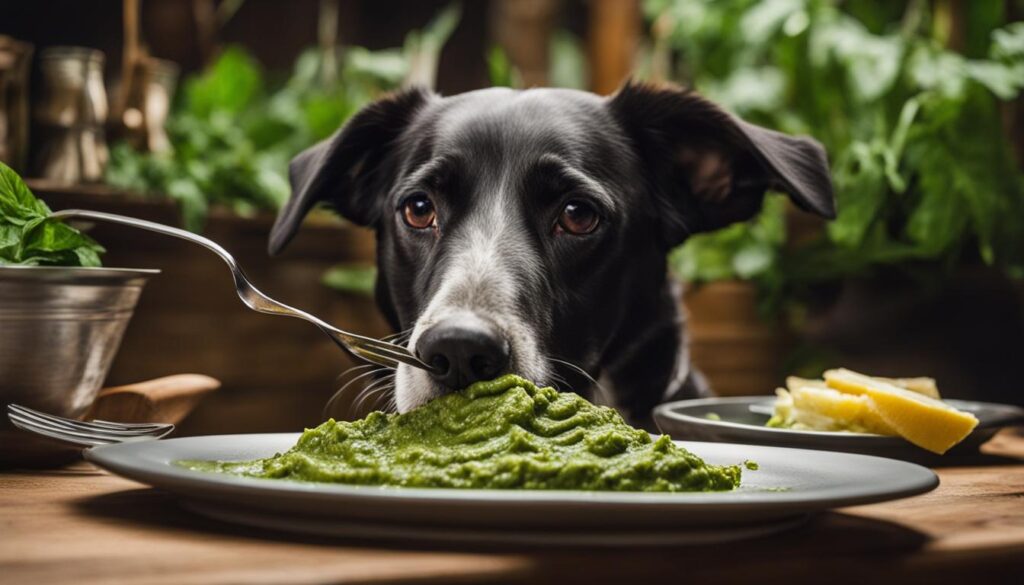
If your dog ingests pesto, immediate action is crucial to ensure their safety. Follow these steps to appropriately respond to the situation:
-
Contact your veterinarian: Call your veterinarian as soon as possible to inform them about the situation. Provide details such as your dog’s size, the amount of pesto consumed, and the specific ingredients in the pesto. Your veterinarian will provide guidance based on this information.
-
Seek professional advice: In addition to reaching out to your veterinarian, consider contacting a pet poison hotline. These hotlines have experienced professionals who can provide immediate assistance and guide you through the necessary steps to manage pesto ingestion in dogs.
-
Induce vomiting with professional guidance: Inducing vomiting in dogs should only be done under the supervision of a professional. They will assess your dog’s condition and advise whether vomiting is necessary and, if so, the correct method to safely induce it.
-
Avoid homemade remedies: It is important to refrain from using homemade remedies without consulting a veterinarian. Homemade remedies may be ineffective or potentially harmful to your dog’s health. Relying on professional advice ensures the most appropriate and safe course of action.
Remember, your veterinarian is the best source of guidance and tailored advice specific to your dog’s situation. Acting promptly and seeking professional assistance is crucial when dealing with pesto ingestion in dogs.
Dog-Friendly Alternatives to Pesto

Instead of feeding your dog pesto, there are plenty of dog-friendly alternatives that you can try. These alternatives provide a safe and healthy option for enhancing your dog’s meals without risking their health. Here are some ideas:
- Homemade Sauces: Prepare homemade sauces using dog-safe ingredients such as parsley, basil, oregano, and thyme. These herbs add flavor to your dog’s food without the risk of toxic ingredients like garlic and onion.
- Low-Sodium Broths: Another option is to use low-sodium broths as a sauce or topping for your dog’s meals. These broths provide flavor while keeping the sodium content low, which is important for your dog’s overall health.
When making homemade sauces or using broths, always ensure that the ingredients are safe and suitable for dogs. Avoid using any herbs, spices, or other ingredients that may be harmful to dogs.
Remember, moderation is key when introducing new flavors to your dog’s diet. Gradually incorporate these alternatives into their meals and observe any changes in their appetite or digestion. If you have any concerns or questions about specific ingredients, consult with your veterinarian for guidance.
| Dog-Friendly Alternatives to Pesto | Benefits | Ingredients |
|---|---|---|
| Homemade Sauces | Safe and flavorful | Parsley, basil, oregano, thyme |
| Low-Sodium Broths | Enhances taste without excess sodium | Low-sodium broth |
By choosing dog-friendly alternatives to pesto, you can ensure that your furry friend enjoys delicious and safe meals. Experiment with different flavors and textures to keep mealtime exciting for your dog. Remember, always prioritize your dog’s well-being and consult with a veterinarian if you have any concerns or questions about your dog’s diet.
Health Risks of Feeding Pesto to Dogs
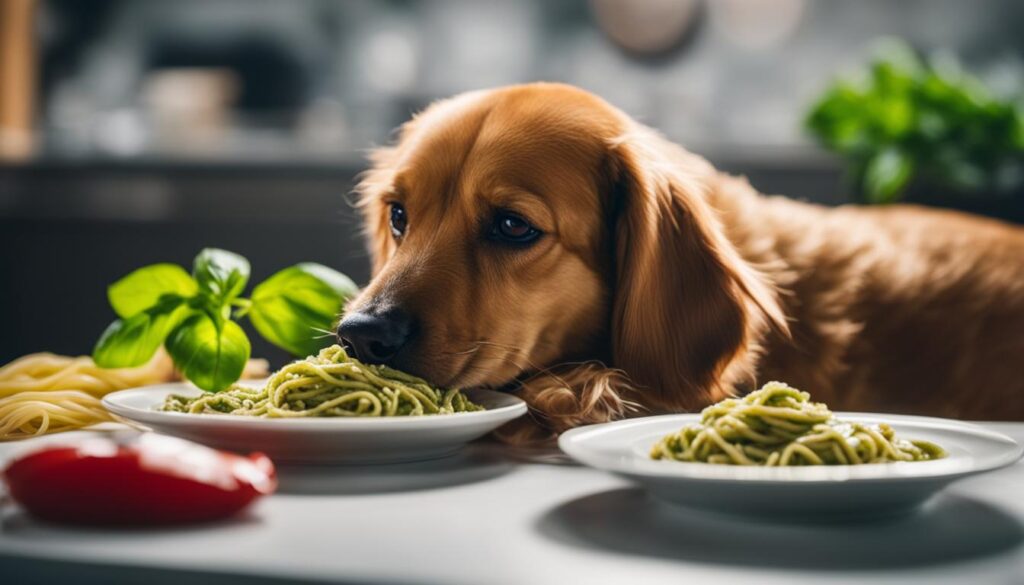
Feeding pesto to dogs can pose significant health risks, as it contains ingredients that are toxic to them and has a high salt and fat content. Let’s take a closer look at the dangers associated with feeding pesto to dogs:
Dangers of Garlic and Onion in Pesto
One of the main ingredients in pesto is garlic and onion, both of which can be highly toxic to dogs. These ingredients contain compounds that can break down a dog’s red blood cells, leading to a condition known as anemia. Symptoms of garlic and onion poisoning in dogs may include increased heart rate, pale gums, rapid breathing, weakness, and even collapse.
Risks of High Salt and Fat Content
Pesto is often high in salt and fat, which can be detrimental to a dog’s health if consumed in excess. Excessive salt intake can lead to salt poisoning, causing symptoms such as dehydration, decreased appetite, lack of coordination, and stomach upset. On the other hand, the high-fat content in pesto can increase the risk of pancreatitis in dogs. Pancreatitis is a condition characterized by inflammation of the pancreas and can result in vomiting, diarrhea, increased thirst and urination, tiredness, and intense abdominal pain.
Symptoms of Garlic and Onion Poisoning in Dogs
If a dog consumes pesto or any other food containing garlic and onion, it is crucial to be aware of the symptoms of poisoning. Some common symptoms of garlic and onion poisoning in dogs include:
- Increased heart rate
- Pale gums
- Rapid breathing
- Weakness
- Collapse
Preventing Risks of Pesto Consumption
To ensure the well-being of your furry friend, it is best to avoid feeding them pesto altogether. Instead, explore dog-friendly alternatives and homemade sauces that are safe for dogs to consume. Prioritize their overall health by consulting with a veterinarian to determine appropriate dietary guidelines for your dog’s specific needs.
| Risks | Effects |
|---|---|
| Garlic and Onion Poisoning | Breakdown of red blood cells, anemia, increased heart rate, pale gums, rapid breathing, weakness, collapse |
| High Salt Intake | Salt poisoning, dehydration, decreased appetite, lack of coordination, stomach upset |
| High Fat Intake | Pancreatitis, vomiting, diarrhea, increased thirst and urination, tiredness, intense abdominal pain |
Homemade Pesto for Dogs
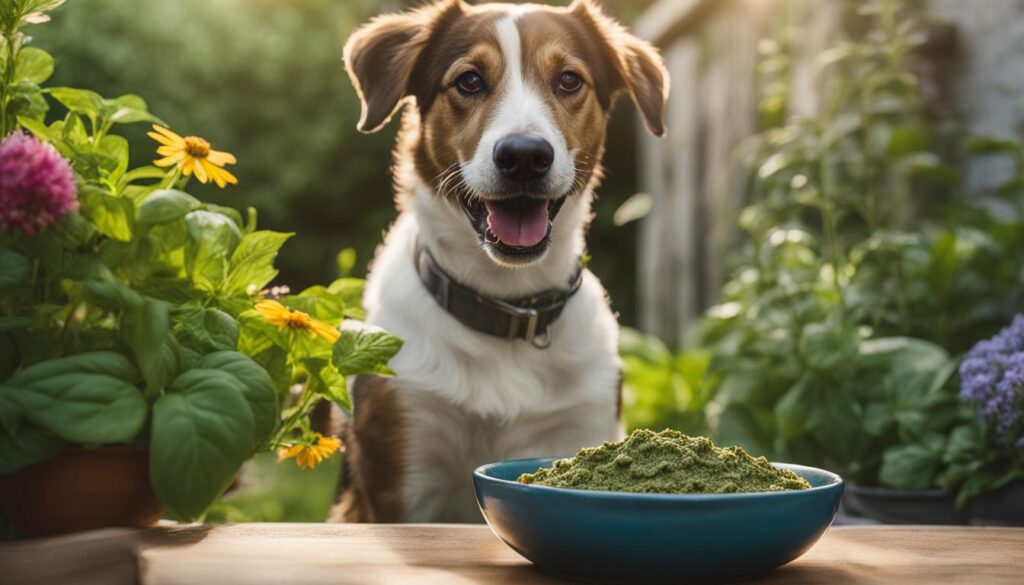
While homemade pesto for dogs can be made without garlic and onion, it is still best to avoid feeding dogs any form of pesto due to the potential risks associated with the high salt and fat content.
However, if you still wish to make homemade pesto for your dog, you can use dog-safe ingredients such as basil, parsley, and other herbs and spices that are safe for dogs to consume. These ingredients can provide flavor and nutritional benefits without posing any risks to your furry friend’s health.
When preparing homemade pesto for dogs, it is important to avoid using any ingredients that are toxic to them, such as garlic and onion. Instead, focus on using dog-friendly herbs and spices that can enhance the taste and provide health benefits.
You can experiment with different combinations of herbs and spices to create a delicious and dog-friendly pesto for your furry companion. Here’s a simple recipe for a garlic-free pesto that dogs can enjoy:
- 2 cups fresh basil leaves
- 1/4 cup fresh parsley leaves
- 1/4 cup fresh cilantro leaves
- 1/4 cup grated Parmesan cheese (optional)
- 1/4 cup olive oil
- 1/4 cup water (or more, as needed, to achieve desired consistency)
Simply blend all the ingredients together until smooth, adding more water if necessary to reach the desired consistency. This homemade pesto can be served as a special treat or used as a flavorful topping for your dog’s regular meals.
Remember to always introduce new foods gradually and monitor your dog for any signs of allergies or digestive issues. If you have any concerns or questions about your dog’s diet, it is best to consult with a veterinarian for personalized advice.
Health Benefits of Pesto for Dogs
While pesto is not safe for dogs to consume, the individual ingredients in pesto can provide some health benefits when used in moderation and without harmful additions like garlic and onion. Let’s explore the nutritional value of basil and other herbs in pesto, as well as the benefits of incorporating dog-safe herbs and spices into your furry friend’s meals.
Nutritional Value of Basil and Other Herbs in Pesto
Basil, a key ingredient in pesto, contains essential nutrients that can contribute to your dog’s overall well-being. It is rich in vitamins A, K, and C, as well as minerals like calcium, iron, and manganese. Additionally, basil is known to act as an anti-inflammatory, which can be beneficial for dogs with inflammation-related conditions.
Other herbs commonly found in pesto, such as parsley, oregano, and thyme, also offer nutritional value. Parsley is a great source of antioxidants and can promote fresh breath for your furry friend. Oregano has antimicrobial properties and may support your dog’s immune system. Thyme contains antioxidants and can aid in digestion.
Benefits of Dog-Safe Herbs and Spices
Integrating dog-safe herbs and spices into your pet’s meals can provide flavor enhancement and potential health benefits. These herbs and spices can serve as natural flavor enhancers without adding harmful ingredients like garlic and onion. Not only do they provide taste, but they can also offer nutritional value and promote well-being.
For example, basil, parsley, oregano, and thyme can add depth of flavor to your dog’s meals, making them more appealing and enjoyable. Additionally, these herbs may have anti-inflammatory, antimicrobial, and digestive benefits, contributing to your dog’s overall health.
Pesto as a Flavor Enhancer for Dog Meals
Although dogs cannot consume pesto directly, you can use pesto as a source of inspiration to create homemade flavor-enhancing sauces for your dog’s meals. By using dog-safe ingredients and avoiding toxic additives, you can add a touch of excitement to your pet’s food while keeping them safe and healthy.
Consider incorporating basil, parsley, or other herbs and spices into your homemade dog-friendly sauce recipes. Remember to choose ingredients that are suitable for dogs and consult with your veterinarian to ensure appropriate dosages and combinations.
Image
Guidelines for Feeding Dogs Pesto
Feeding dogs pesto can pose serious risks to their health, and it is best to avoid including this sauce in their diet. Pesto contains toxic ingredients such as garlic and onion, which can lead to anemia and other severe symptoms in dogs. Additionally, pesto is high in salt and fat, which can be harmful when consumed in excess.
Instead of feeding dogs pesto, it is important to focus on providing them with a balanced and appropriate diet that meets their nutritional needs. This can be achieved by consulting with a veterinarian who can provide specific guidelines and recommendations tailored to your dog’s size, age, and health condition.
Moderation is key when it comes to any dog’s diet. While it may be tempting to treat your dog to human foods like pesto, it is crucial to prioritize their overall well-being over indulgence. Dogs have specific dietary requirements that can only be met through a carefully planned and controlled diet.
Consulting with a veterinarian is essential in ensuring that your dog is receiving the appropriate nutrients and avoiding potential risks. By following their guidance, you can provide your dog with a safe and healthy diet that will contribute to their long-term well-being.
Feeding dogs a balanced and appropriate diet is essential for their overall health and happiness. While it may be tempting to share human foods like pesto with your furry friend, it is important to understand the risks involved and make informed decisions based on professional advice.
Risks of Homemade Remedies for Pesto Ingestion
When your dog ingests pesto, it’s important to exercise caution and seek professional help rather than resorting to homemade remedies. While your first instinct may be to induce vomiting at home, this can be dangerous and potentially worsen the situation. Therefore, it is crucial to consult a veterinarian or contact a pet poison hotline for guidance.
Using homemade remedies without proper professional advice can be ineffective and may lead to complications. The risks associated with homemade remedies for pesto ingestion can vary depending on the specific ingredients involved and the unique circumstances of your dog’s situation. Without accurate knowledge and understanding, you may unknowingly exacerbate the issue.
By reaching out to a veterinarian or pet poison hotline, you gain access to expert advice tailored to your dog’s size, the amount of pesto ingested, and any specific ingredients in the pesto. Seeking professional help ensures the best course of action to address the situation effectively and minimize potential harm.
It is always important to prioritize your pet’s well-being and consult professionals who possess the knowledge and experience to handle such situations. Trusting the expertise of veterinarians and pet poison hotlines provides peace of mind and ensures that your dog receives the appropriate care required in pesto ingestion cases.
Wrapping Up
In conclusion, it is important to note that dogs cannot eat pesto due to the presence of toxic ingredients and high levels of salt and fat. Garlic and onion, commonly found in pesto, can lead to anemia and severe symptoms in dogs, such as increased heart rate, pale gums, and rapid breathing. The high salt content in pesto can result in salt poisoning, causing dehydration and stomach upset. Additionally, the high fat content in pesto can lead to pancreatitis, a potentially life-threatening condition characterized by vomiting, diarrhea, and intense abdominal pain.
To ensure the safety and well-being of your furry friends, it is best to avoid feeding them any form of pesto. Instead, explore dog-friendly alternatives by creating homemade sauces using dog-safe ingredients. Consider using herbs and spices such as basil, parsley, oregano, and thyme to add flavor to your dog’s meals. These ingredients provide nutritional benefits without posing any harm to your dog’s health.
Remember to consult with a veterinarian for appropriate diet guidelines tailored to your dog’s specific needs. By prioritizing your dog’s overall health and avoiding potentially harmful foods like pesto, you can ensure they enjoy a safe and nourishing diet.
FAQ
Is pesto safe for dogs to eat?
No, pesto is not safe for dogs to eat. It contains ingredients like garlic and onion, which are toxic to dogs and can cause severe symptoms and even death.
Why is pesto toxic to dogs?
Pesto is toxic to dogs because it contains ingredients like garlic and onion, which can break down a dog’s red blood cells, leading to anemia and severe symptoms. Pesto is also high in salt and fat, which can be dangerous to dogs in excessive amounts.
Can dogs eat homemade pesto?
No, dogs should not be given homemade pesto, as it still contains ingredients like garlic and onion that are toxic to them. It is best to avoid feeding dogs any form of pesto.
What should I do if my dog eats pesto?
If your dog eats pesto, it is important to take immediate action. Contact your veterinarian or a pet poison hotline for guidance on what to do based on your dog’s size, the amount of pesto ingested, and the specific ingredients in the pesto.
What are the dog-friendly alternatives to pesto?
Instead of feeding your dog pesto, consider homemade sauces made with dog-safe ingredients such as basil, parsley, and other herbs and spices. You can also use low-sodium broths or bone broth as a flavorful topping for your dog’s meals.
What are the health risks of feeding pesto to dogs?
Feeding pesto to dogs can pose various health risks, including garlic and onion poisoning, salt poisoning, and pancreatitis. These conditions can cause severe symptoms and even be life-threatening.
Can I make homemade pesto for my dog?
While homemade pesto for dogs can be made without garlic and onion, it is still best to avoid feeding dogs any form of pesto due to the potential risks associated with the high salt and fat content.
Are there any health benefits of pesto for dogs?
While pesto is not safe for dogs to consume, the individual ingredients in pesto can have health benefits for dogs when used in moderation and without harmful additions. Basil, for example, acts as an anti-inflammatory and may have a calming effect on anxious dogs.
What are the guidelines for feeding dogs pesto?
It is best to avoid feeding dogs pesto altogether and provide a balanced and appropriate diet for your dog that meets their nutritional needs. Moderation is key, and it is important to consult with a veterinarian for specific guidelines.
What are the risks of homemade remedies for pesto ingestion?
Homemade remedies for pesto ingestion can be ineffective or potentially harmful. Inducing vomiting at home should only be done under the guidance of a professional. It is best to seek professional advice from a veterinarian or a pet poison hotline in these situations.


